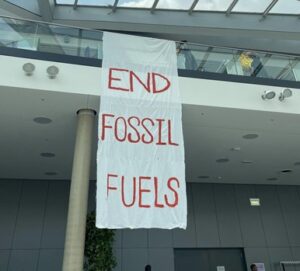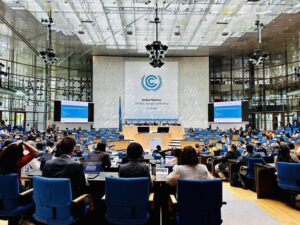The COP29 brings new developments in climate financing. Whether positive or negative, to understand what is happening, we must first understand what we are talking about when we talk about how it will be financed.
If there is something that many of us wonder about, it’s what climate financing is, because although the term seems self-explanatory, when we talk about climate negotiations such a definition does not exist.
 (Action during SB58, prior to the presence of the COP 28 presidency)
(Action during SB58, prior to the presence of the COP 28 presidency)
There are some things that are quite clear, and in this article, we will provide some keys and a bit of general context to understand what this contentious issue is about, which will revolutionize the Republic of Azerbaijan and the entire world in the coming weeks.
As we mentioned earlier, there is a major issue regarding climate financing, and that is no consensus on the official definition of the term, something crucial if our task is to build legislation on this subject.
However, we will venture into a definition, perhaps somewhat simple, of what this concept means: climate financing: is the financial resources mobilized by States aimed at reducing greenhouse gas emissions (mitigating) and adapting to the consequences of climate change.
Finally, we come to our first crossroads, and the definition we just outlined excludes an essential part of climate financing, especially for developing countries like Argentina. While we refer to adaptation and mitigation, the missing piece of this definition is compensation for loss and damage: the costs incurred when unable to mitigate enough for climate events not to occur or carry out actions to adapt to them. Thus, we could update our definition by adding to it “…and compensation for the losses and damages resulting from the adverse effects of the climate crisis.”
Now we are approaching a more complete definition of what climate financing is. But two components are missing: Who should provide these resources or in what direction should financial flows go? And on the other hand, how much money should we invest in this?
At this point, controversy is inevitable, and this is where negotiations on climate financing become significantly complex, pitting two sides with -almost- irreconcilable positions against each other.
 (Action during SB58, prior to the presence of the COP 28 presidency)
(Action during SB58, prior to the presence of the COP 28 presidency)
While developing countries demand -in line with the principle of common but differentiated responsibilities– that climate financing should mainly come from public sources and in the form of donations provided by developed countries as compensation for the consequences of their historical greenhouse gas emissions, developed countries seek to evade this responsibility at all costs, and above all, increase the contributor base to include certain middle-income countries exempt from this obligation, such as China or India.
To understand the issue of the amount, the Quantum, as it is called in the jargon of international negotiations, we must look back. It was the year 2009, and the world was getting ready to host one of the most emblematic climate change summits in history: COP15 in Copenhagen, where unprecedented agreements were expected to be reached to put an end to climate change once and for all.
Unfortunately, these aspirations were too great, and the summit was a great disappointment, although we did achieve a novel advance in terms of financing: developed countries committed to provide $100 billion annually that would be allocated to developing countries for climate action until 2020.
In COP21, with the signing of the Paris Agreement, this goal was extended temporarily, and it was decided that the $100 billion would be mobilized until 2025, the year in which the climate financing goal would need to be updated. Despite the novelty of the fact, the funds were never fully mobilized, and developed countries kept their contributions below the agreed amount until 2022.
According to the OECD report, only in that year was that amount mobilized, while between 2013 and 2021 the maximum amount was $89.6 billion, including contributions from private sources. It is worth noting that even the figures for 2022 are still being debated by developing countries, making the demand for climate financing increasingly pressing.
Today, as 2024 slips through our fingers, we are approaching the end of the current global financing goal, and we are getting closer to COP29, where, if all goes well, the New Collective and Quantified Climate Financing Goal (or NCQG, for short) will be defined, establishing the amount of climate financing to be mobilized over the next 5 to 10 years, with a minimum floor of $100 billion annually.
It would seem that the path is clear to achieve a new global goal, that everything will be resolved easily, and we are on the verge of victory, but how are the negotiations going? The answer is simple: poorly. As we saw before, achieving an ambitious outcome is complex, and

